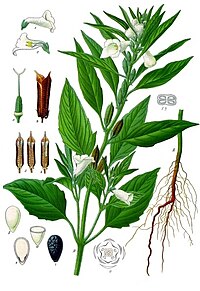
Photo from wikipedia
Abstract Wastewater containing chemical energy and water resources is supposed to be efficiently recovered and utilized. However, conventional wastewater treatment, which is energy intensive and costly, focuses on the degradation… Click to show full abstract
Abstract Wastewater containing chemical energy and water resources is supposed to be efficiently recovered and utilized. However, conventional wastewater treatment, which is energy intensive and costly, focuses on the degradation of pollutants but ignores the reuse of resources. This study explored the feasibility of integrating wastewater treatment with biofuel production by oleaginous yeasts Rhodosporidium toruloides for sustainability concerns. Aerobic fermentation of R. toruloides was used to treat synthetic sugar-containing wastewater (SSCW) and synthetic sugar-containing wastewater anaerobic fermentation broth (SSCW-AFB). Flux balance analysis (FBA) was used to explore the optimal metabolic flux distributions for lipid production, and the potential of R. toruloides to utilize acetic acid was studied through metabolic network analysis for the first time. Sequencing batch cultivation was used to enhance nutrient removal and microbial lipid accumulation, achieving 87.0 ± 2.4% and 61.0 ± 0.1% total organic carbon (TOC) removal coupled with 30.6 ± 1.1% and 73.5 ± 0.7% lipid content in SSCW and SSCW-AFB, respectively. The in silico results revealed that nicotinamide adenine dinucleotide phosphate (NADPH)-producing flux of R. toruloides grown on acetic acid preferred going through malic enzyme related pathways rather than the pentose phosphate pathway, resulting in less 15.6% CO2 emissions which in turn facilitates the lipid accumulation. Consistent with the model predictions, a higher lipid coefficient (147.0 mg/g acetic acid) was achieved in SSCW-AFB compared with that in SSCW (105.3 mg/g glucose) during the bioprocess. Furthermore, the lipid production performance under a low seed cell density (0.4 g/L) was significantly better than that under a high seed cell density (4 g/L). Analysis of the biofuel properties indicated the suitability of using SSCW and SSCW-AFB as feedstocks for the industrial production of biodiesel. The results of this study provide valuable information for promoting resource and energy recovery and reducing carbon emission during the wastewater biological treatment process by oleaginous microorganisms.
Journal Title: Journal of Cleaner Production
Year Published: 2021
Link to full text (if available)
Share on Social Media: Sign Up to like & get
recommendations!